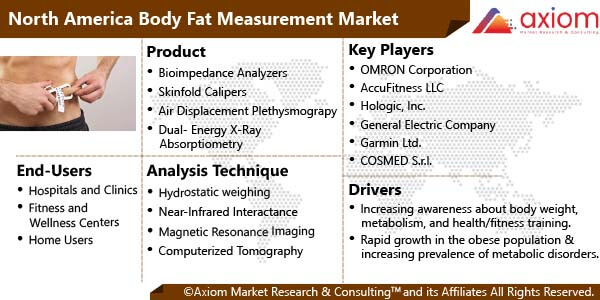Body fat measurement is necessary to analyze the low or high fat in the body and its associated risk. Body fat is measured using body fat analyzer. This device accurately measures the body fat. The body fat measuring device is applied to the skin and a weak current is passed between the outer two electrodes. As this high frequency current passes through the skin, the muscles and the subcutaneous fat, some amount of energy is lost due to the tissue resistance. This change in the energy is then measured with the help of two inner electrodes which help to determine the fat in the body.
Market Outlook: North America Body Fat Measurement Market
Body fat measurement is essential nowadays to analyze the health. In North America, the increasing number of obese population is a concern and also driving the market. Moreover, the consciousness towards a healthy lifestyle is adding fuel to the market for body fat measurement. Also, the advanced healthcare infrastructure in contributing towards the market growth. However, the high cost associated with the devices may restraint the market growth.
COVID 19 Impact on North America Body Fat Measurement Market
The outburst of covid 19 led to the worldwide lockdown. The sedentary lifestyle of people raised the risk of obesity among the population. Also, there is presence of large obese population in north America. The obesity was linked with impaired immune system which raised the risk of infections. This increased the concern among the population and raised the demand of products for effective weight management.
North America Body Fat Measurement Market Segmental Overview
In North America, the fat measurement market is segmented based upon the products, analysis techniques and the end users.
North America Body Fat Measurement Market based Upon the Products
In North America, the market for products is segmented by bioimpedance analyzers, skinfold calipers, air displacement plethysmography, dual-energy x-ray absorptiometry. The bioimpedance analyzers hold the largest market share owing to continuous technical improvement in order to meet the growing needs of individuals. Also its easy usage and cost effectiveness is adding fuel to the market growth.
North America Body Fat Measurement Market Based Upon the Analysis Techniques
In North America, the various analysis techniques available in the market are hydrostatic weighing, near-infrared interactance, magnetic resonance imaging, computerized tomography. Hydrostatic weighing holds the largest market share owing to its accuracy and safety over the other analyzing techniques.
North America Body Fat Measurement Market Based Upon the End Users
In North America, the various end users of body fat measurement are hospitals and clinics, fitness and wellness centers, home users and others. Hospitals and clinic segment holds the largest share in the market. However, wellness and fitness centers are anticipated to grow at faster rate during the forecast period.
North America Body Fat Measurement Market Based Upon the Countries
In North America, the different countries studied are United States, Canada and Mexico. U.S. holds the prominent position in the region. This is due to large obese population in the country and adoption of effective weight management products. Also, the Canada holds a significant positon owing to the advanced healthcare infrastructure.
North America Body Fat Measurement Market Key Players
Some of the market key players acting in the market are OMRON Corporation, AccuFitness LLC, Hologic, Inc., General Electric Company, Garmin Ltd., COSMED S.r.l., Tanita, Xiaomi, Beurer GmbH, Inbody Co. Ltd., Exertech, Bodystat Ltd.
Recent Development:
OMRON Corporation: In July 2020, Omron Healthcare collaborated with Mount Sinai Health System of New York to offer patients its new VitalSight home blood pressure monitoring solution.
InBody USA: In January 2020, InBody USA launched the InBody 970 device. The device uses a novel technology to categorize and analyze abdominal fat and total body water.
Hologic Inc.: In March 2019, Hologic, Inc. signed an agreement with DEXA+ for the distribution of Hologic’s Horizon® DXA system for body composition measurement. This partnership allows Hologic to expand its expertise in body composition assessment and the reach of its market-leading DXA system.
Tanita Corporation: In 2018, Tanita Corporation launched its award-winning Tanita Health Program across the US. Tanita Health Program is an integrated suite of hardware and software that helps employers improve the health of their employees. For employers, the program offers a proven track record in reducing employee healthcare expenditures. For employees, it offers an easy and engaging way to visualize their progress.











